"Hanshita," or Black Ink "Key-block" Outlines
(Doi Publisher Examples)
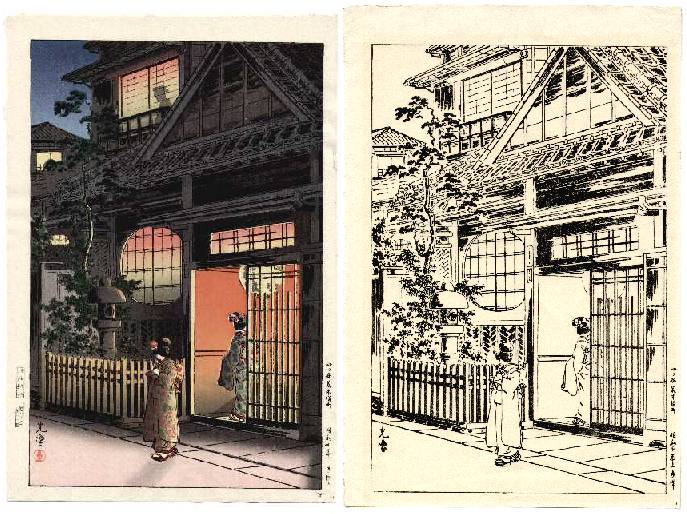
Koitsu's "Tea House at Night" (1935); "Hanshita" for "Tea House at Night"
Introduction--What are "Hanshita??"
A very interesting component of the complex, multi-stepped printing process required to produce any Japanese woodblock is what I'll refer to here as a "key-block outline," or "hanshita." To understand more about how these "hanshita" (black outline prints) become the actual foundation to the final MULTI-colored print, a little background in order.
Historical Background
The earliest "ukiyoe-e" prints with which many of us are readily familiar are the monochromatic (black outline only) prints of the late 1600's which were commonly printed then (and continuing much later) as individual prints or as multi-paged "e-hon" (small, woodblock-printed books). Of course, such prints existed as illustrations only, as images combined with text, or even as text alone. These hand-printed, rather "primitive," black and white prints were essentially the Japanese equivalent of the books and illustrations produced by European printing presses.
Shortly thereafter, these earliest monochromatic prints were later "improved" via hand-tinting which was done to add simple colors to certain areas of these prints. Of course, this was a very labor intensive and tedious process.
Finally, in this developmental process, it was realized by these early artisans that to easily and efficiently "over-print" these desired multiple colors onto the same sheet of paper, some method of repeated accurate alignment (we now call "registration") was necessary to ensure that the finished colors ended up applied accurately to the "correct areas" of the print. Once this technical hurdle (of alignment) was overcome, the result then became the beautiful multi-colored prints that we today think of as "ukiyo-e."
To achieve this consistent and repeated accurate alignment, of course most of us are already familiar with the use of "kento" cuts. For those that are not, these two "kento" are the raised "L-shaped" and raised "straight-shaped" guides that are carved into the lower corner and along one edge of EACH of the print's various woodblocks. Against and into each of these guides is inserted the edge and corner of each sheet of paper as it is moved from woodblock to woodblock in the multi-day printing process; as separately carved woodblocks are of course required to print each individual color.
(For a more detailed description and some photographs of the actual printing process, please refer to this year 2000 article: "Modern Day Woodblock Printers Still Living In Japan.") To further accurately describe the "kento" process, if done "properly," the "kento" are actually raised additions (either by nailing or gluing) of narrow strips of wood atop the original uncarved blocks. Many carver however simply do it "fast and dirty" by instead simply carving "pits" down into the blocks. (One drawback to this method, however, can be the accumulation of excess printing inks down into these "pits," resulting in the occasional "light dirty triangle" seen in some print's lower right corners.)
How Printing is Done
The initial step of the carving process involves the use of the artist's original sketch--finalized on thin paper and now known as a "hanshita"--which is glued upside down (must be reversed) onto the flat surface of a cherrywood block. The carver then begins the tedious and very exacting task of carving (cutting through this glued "hanshita" paper) along both edges of all the sketch's lines, resulting in only very thin, raised edges left standing in relief, with all excess surface wood being carved away. What remains then-after many tedious and seemingly endless hours of work-is known as the "key-block" which is used to print the BLACK outlines seen in the print.
How "Hanshita" Fit In (Pun Intended)
Next, by inking this "key-block" (and including in these printings it's two raised "kento") with black ink, several black-outlined copies are printed (again onto thin papers) which after being dried essentially become the "templates" needed to transfer this "key-block's" black outlines and relative "kento" placements (by again gluing face down ) onto the surfaces of each of the additional, yet-uncarved, woodblocks. These resulting "black lines" then define the boundaries of each of a print's blocks individual color areas. As before, the carver then carves away much of the surfaces of these various woodblocks, in each case leaving standing in "relief" the various areas needed to print that specific color.
In other words, these simple "black outlines" thusly become the vehicle by with a print's design (and it's insured "registration") is transferred to each of a print's multiple blocks. Their use guarantees that all the over-printed colors "fit." This is the typically "unappreciated aspect" of how these "key-block outlines" are critical to the carving process-not only is the black "key-block" printed with black ink to produce any "black lines" seen in the final print, but (as explained above) earlier duplicate copies from this same "key-block" also become the vehicle by with this duplicate design is transferred to all of the other colored woodblocks for their carving.
(In a purely technical sense, these subsequent multiple "black outline prints" are correctly then called "kyogo" (impressions taken from the "key-block" for the purpose of making "iro-sashi"-with "iro-sashi" being the multiple sheets that delineate where each specific color is then carved) However for the sake of understanding, we'll simply refer to ALL of these "black outline prints" as "hanshita.")
Original "Hanshita" Examples from Doi Publishers
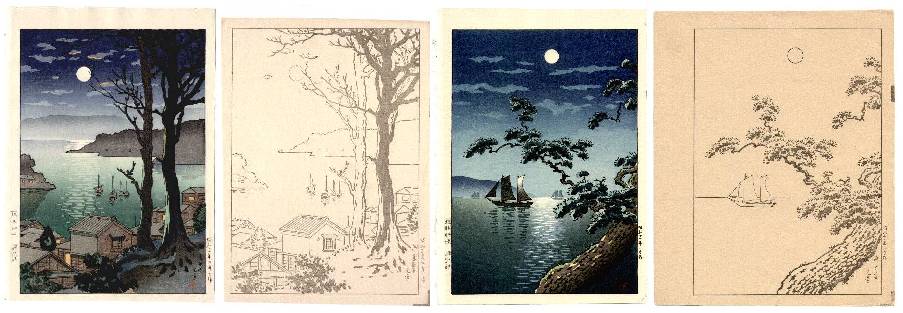
Koitsu's "Port Manazuru" (1936) Koitsu's "Maiko Beach" (1936)
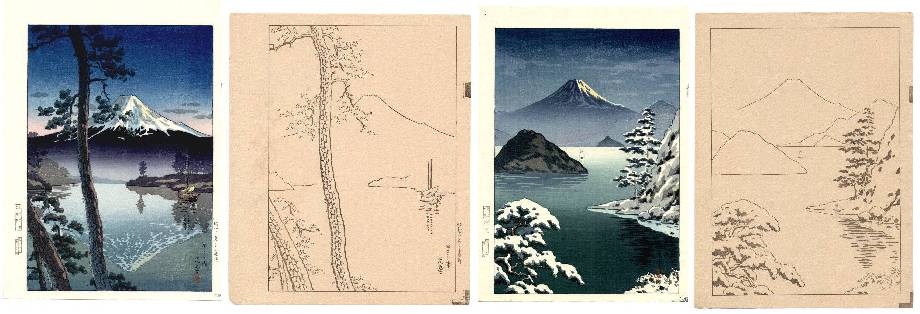
Koitsu's "Tago Bay" (1936) Koitsu's "Mito Beach" (1936)
As can be seen from the above examples (all are 1932-36 original "hanshita"), there is an immediate visual appeal upon viewing a "black outline print" alongside the identical completed multi-color print. Of course, these paired-images are seen as duplicates, since the colored print actually evolved directly from the "black outline print." And the viewer, in a purely aesthetic sense, is struck with the impression that he/she is, it seems, viewing the artist's "original sketch." And indeed, only one step removed, he/she is viewing the artist's original pen or pencil sketch.
Dating of Doi's "Hanshita" via the "Disappearing Moon"
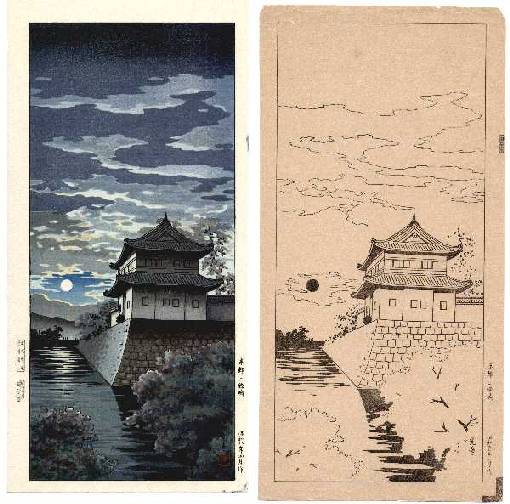
Koitsu's "Nijo Castle, Kyoto" (1933)
At the time when this "hanshita" assemblage was acquired last year, I immediately began to wonder exactly "how old" these "hanshita" truly were. Being unsealed prints (bearing no "printer's seal"), at first there seemed little concrete to go on, other than the readily apparent aging of their paper. Experience readily told me that they certainly appeared to be pre-War, but still I continued to wonder more precisely as to their true dating.
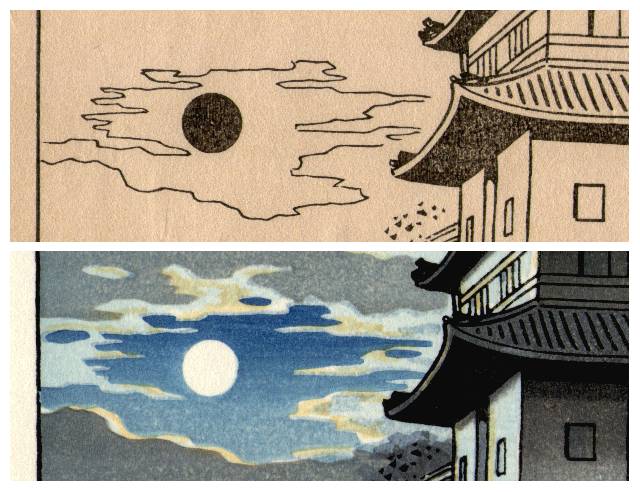
Koitsu's "Nijo Castle, Kyoto" (1933) Close-up
Then, due to a VERY astute observation made by a close friend and fellow shin-hanga collector, this "dating" question was suddenly answered. Upon questioning the presence of the oddly "SOLID BLACK full moon" seen in the "Nijo Castle" print's "hanshita," the realization was then made that these "hanshita" were in fact, very early strikes make off of these prints' black "key-blocks." And that, furthermore, these "hanshita" actually PRE-dated ALL subsequent full color copies make of their same images.
A Little Detective Work…..And Some Common Sense
Ok so you ask, "How can you know positively that these "hanshita" are really that old?" Well, simple. Giving careful thought to the process of how the first use of the "key-block" was to produce the additional identical copies (themselves also used as "hanshita") which were used in the carving the colored woodblocks, the presence of a "solid black full moon" was the key.
If the "key-block's" full moon was actually printed in black (that is, left raised, inked, and printed on the final print), then we would expect to see a "black ink moon" on the final color print-which we do not. In fact, it's been carved away!! In the finished color print, there's NO black seen in the "moon," not even a thin black outline. Simply gone.
What's happened here in the printing/carving process, is that to "transfer" the moon's exact placement to the "blue" (sky color) woodblock, the carver simply found it much EASIER to carve one solid round circle rather than to carve a thin "two-sided" black round circle. Since only the "shape and location" was the necessary result (to be transferred to the other "blue sky" woodblock) and since NO actual "black" would actually remain to be printed in the "finished moon," the carver then simply CARVED THE BLACK MOON OFF of the black "key-block" as soon as the additional "hanshita" were printed. Hence, proof positive that this "hanshita" positively PRE-dates any subsequent full color copy made.
The SAME observation can also be easily made with regards to the thin black "cloud
outlines" that are seen in the black outline "hanshita," but again, there's no trace of this black seen in the finished color print. Again, these outlines were only printed as additional "hanshita" that were then glued upon the colored woodblocks acting as a "template" for accurate carving, but were then immediately carved OFF of the black ink "key-block" as soon as the actual multicolor--INCLUDING visible black ink--printing was begun.
A logical extension then--since this "hanshita" assemblage was all acquired at the same time from the same source--was that they all must certainly belong to the same pre-color printing vintage. And certainly, the consistently aged papers would confirm that judgement. (For a related article on dating prints via their papers, please see the
article: "Old Paper" (Unsodo and Shobisha Publishers).")
Furthermore, close examination of some of the other designs also yields several other similar subtle "changes" made between the "black outline prints" and their paired color images.
Another Doi Publisher Example
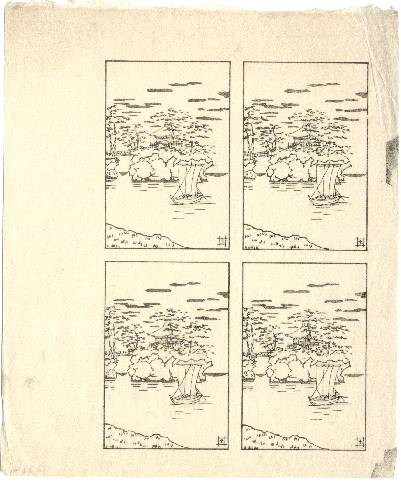
Koitsu's small "Matsushima" Greeting Cards -- Set of 4 via "Hanshita"
I've occasionally heard the observation made that there appears to be slight "variations" among different copes of Doi's small (3 x 5 inch) "greeting card" prints. These hand-printed "gems" were often used on the fronts of Japanese-printed Christmas cards commonly printed during the 1930's to the 1950's/60's. These printing "variations" observed have led some persons to believe that perhaps some copies were "earlier copies" and that some must be "later copies" made from newly re-carved blocks.
The presence of the uncut "four-in-one" woodblock "hanshita" seen above, however, would seem to debunk that theory of "earlier copies" and "later copies." Rather, it seems more likely that the observed variations are more likely simply that: since FOUR distinct, and unavoidably slightly "different" copies, are indeed produced efficiently and simultaneously during one inking and printing.
Concluding Remarks
Hopefully the reader now has a far greater understanding and appreciation of the complex, multi-stepped process involving both the printing, then carving, then final color printing of each and every woodblock.
Also demonstrated was the powers of close observation when coupled with a small amount of deductive reasoning to answer the broad question: "How did the Japanese artisans produce these prints?
So, perhaps now it's time to dig out some of your own prints and then sit back contemplatively marveling in their complexity. And at the same time, their artistic simplicity.
Enjoy your prints!!
Copyright 2002, Thomas Crossland. All rights reserved.
Gallery
Terms
Ordering
About Us
We Buy Prints
Library






